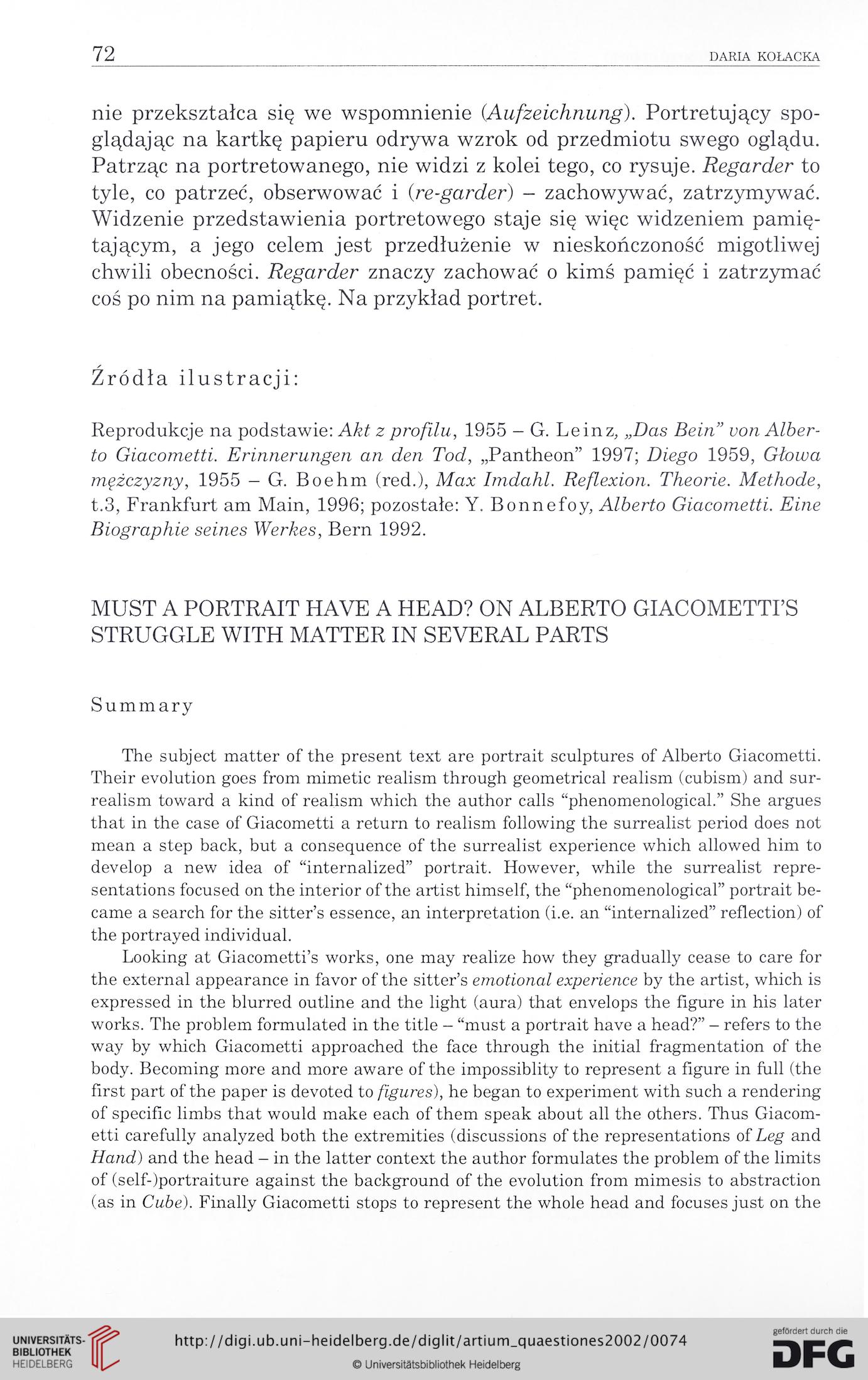72
DARIA KOŁACKA
nie przekształca się we wspomnienie (Aufzeichnung). Portretujący spo-
glądając na kartkę papieru odrywa wzrok od przedmiotu swego oglądu.
Patrząc na portretowanego, nie widzi z kolei tego, co rysuje. Regarder to
tyle, co patrzeć, obserwować i (re-garder) - zachowywać, zatrzymywać.
Widzenie przedstawienia portretowego staje się więc widzeniem pamię-
tającym, a jego celem jest przedłużenie w nieskończoność migotliwej
chwili obecności. Regarder znaczy zachować o kimś pamięć i zatrzymać
coś po nim na pamiątkę. Na przykład portret.
Źródła ilustracji:
Reprodukcje na podstawie: Akt z profilu, 1955 - G. Leinz, „Das Bein” uon Alber-
to Giacometti. Erinnerungen an den Tod, „Pantheon” 1997; Diego 1959, Głowa
mężczyzny, 1955 - G. Boehm (red.), Max Imdahl. Reflexion. Theorie. Methode,
t.3, Frankfurt am Main, 1996; pozostałe: Y. Bonnefoy, Alberto Giacometti. Eine
Biographie seines Werkes, Bern 1992.
MUST A PORTRAIT HAVE A HEAD? ON ALBERTO GIACOMETTPS
STRUGGLE WITH MATTER IN SEYERAL PARTS
Summary
The subject matter of the present text are portrait sculptures of Alberto Giacometti.
Their evolution goes from mimetic realism through geometrical realism (cubism) and sur-
realism toward a kind of realism which the author calls “phenomenological.” She argues
that in the case of Giacometti a return to realism following the surrealist period does not
mean a step back, but a conseąuence of the surrealist experience which allowed him to
develop a new idea of “internalized” portrait. However, while the surrealist repre-
sentations focused on the interior of the artist himself, the “phenomenological” portrait be-
came a search for the sitter’s essence, an interpretation (i.e. an “internalized” reflection) of
the portrayed individual.
Looking at Giacometti’s works, one may realize how they gradually cease to care for
the external appearance in favor of the sitter’s emotioncil experience by the artist, which is
expressed in the blurred outline and the light (aura) that envelops the figurę in his later
works. The problem formulated in the title - “must a portrait have a head?” - refers to the
way by which Giacometti approached the face through the initial fragmentation of the
body. Becoming morę and morę aware of the impossiblity to represent a figurę in fuli (the
first part of the paper is devoted to figures), he began to experiment with such a rendering
of specific limbs that would make each of them speak about all the others. Thus Giacom-
etti carefully analyzed both the extremities (discussions of the representations of Leg and
Hand) and the head - in the latter context the author formulates the problem of the limits
of (self-)portraiture against the background of the evolution from mimesis to abstraction
(as in Cube). Finally Giacometti stops to represent the whole head and focuses just on the
DARIA KOŁACKA
nie przekształca się we wspomnienie (Aufzeichnung). Portretujący spo-
glądając na kartkę papieru odrywa wzrok od przedmiotu swego oglądu.
Patrząc na portretowanego, nie widzi z kolei tego, co rysuje. Regarder to
tyle, co patrzeć, obserwować i (re-garder) - zachowywać, zatrzymywać.
Widzenie przedstawienia portretowego staje się więc widzeniem pamię-
tającym, a jego celem jest przedłużenie w nieskończoność migotliwej
chwili obecności. Regarder znaczy zachować o kimś pamięć i zatrzymać
coś po nim na pamiątkę. Na przykład portret.
Źródła ilustracji:
Reprodukcje na podstawie: Akt z profilu, 1955 - G. Leinz, „Das Bein” uon Alber-
to Giacometti. Erinnerungen an den Tod, „Pantheon” 1997; Diego 1959, Głowa
mężczyzny, 1955 - G. Boehm (red.), Max Imdahl. Reflexion. Theorie. Methode,
t.3, Frankfurt am Main, 1996; pozostałe: Y. Bonnefoy, Alberto Giacometti. Eine
Biographie seines Werkes, Bern 1992.
MUST A PORTRAIT HAVE A HEAD? ON ALBERTO GIACOMETTPS
STRUGGLE WITH MATTER IN SEYERAL PARTS
Summary
The subject matter of the present text are portrait sculptures of Alberto Giacometti.
Their evolution goes from mimetic realism through geometrical realism (cubism) and sur-
realism toward a kind of realism which the author calls “phenomenological.” She argues
that in the case of Giacometti a return to realism following the surrealist period does not
mean a step back, but a conseąuence of the surrealist experience which allowed him to
develop a new idea of “internalized” portrait. However, while the surrealist repre-
sentations focused on the interior of the artist himself, the “phenomenological” portrait be-
came a search for the sitter’s essence, an interpretation (i.e. an “internalized” reflection) of
the portrayed individual.
Looking at Giacometti’s works, one may realize how they gradually cease to care for
the external appearance in favor of the sitter’s emotioncil experience by the artist, which is
expressed in the blurred outline and the light (aura) that envelops the figurę in his later
works. The problem formulated in the title - “must a portrait have a head?” - refers to the
way by which Giacometti approached the face through the initial fragmentation of the
body. Becoming morę and morę aware of the impossiblity to represent a figurę in fuli (the
first part of the paper is devoted to figures), he began to experiment with such a rendering
of specific limbs that would make each of them speak about all the others. Thus Giacom-
etti carefully analyzed both the extremities (discussions of the representations of Leg and
Hand) and the head - in the latter context the author formulates the problem of the limits
of (self-)portraiture against the background of the evolution from mimesis to abstraction
(as in Cube). Finally Giacometti stops to represent the whole head and focuses just on the




